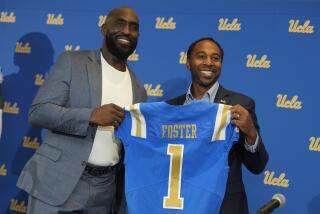Suit Is Real Capper for NCAA
- Share via
Three former college athletes are suing under federal antitrust law to force the NCAA to pay as much as $345 million to current and past players whose scholarships failed to cover the full cost of attending college.
The class-action lawsuit, filed Friday in U.S. District Court in Los Angeles, seeks to represent thousands of athletes who have played for more than 100 major colleges during the last four years.
While the suit does not seek specific damages, it does suggest that each athlete is owed about $2,500 for each year when financial aid failed to cover the costs of attending school. Class-action lawsuits allow for triple damages, which could push total damages to $345 million.
The former athletes who filed the suit -- football player Jason White (Stanford), basketball player Jovan Harris (San Francisco) and football player Brian Polak (UCLA) -- were not available for comment. Attorneys who filed the suit also declined to comment.
The lawsuit targets an NCAA-imposed cap that limits the amount of financial support that football and basketball players can receive from NCAA schools. On average, according to the lawsuit, student-athletes face $2,000 to $3,000 in out-of-pocket expenses each year -- the difference between the cap and the cost of attending school.
The NCAA said the suit was without merit.
“We are surprised by the lawsuit because the scholarship stipends that our student-athletes get can be augmented by other forms of assistance, including academic scholarships and need-based grants that can bring them up to the full cost of attendance,” spokesman Erik Christianson said Wednesday. “Athletes also can work part-time as well, so we believe these claims are without merit.”
The suit comes as the NCAA is celebrating its 100th anniversary and preparing for the financially lucrative college basketball tournament, culminating in the Final Four in Indianapolis the first week of April. It is the latest development in the ongoing dispute over whether the athletes who play football and basketball at large NCAA schools are getting their fair share of the riches created by big-time sports programs.
The lawsuit would force the NCAA to amend its cap by giving member institutions the right to determine whether athletic financial-aid packages would fully cover tuition, room and board, books and other expenses. The existing cap does not allow institutions to pay all costs, but schools can award ancillary funds to athletes.
NCAA President Myles Brand has said he supports an increase in athletic financial-aid packages by as much as $3,000. But Christianson said that Brand’s opinion notwithstanding, member institutions “clearly have the right to set these kinds of limits, and they’ve been set.”
The lawsuit is an outgrowth of an ongoing campaign by athletes, including former UCLA football player Ramogi Huma, who are pushing the NCAA to modify its financial aid rules.
“We’ve made some progress over the years, but the NCAA has not moved far enough or fast enough,” said Huma, who is not a direct party to the suit. “We still have athletes without basic protections, so now is the time to act.”
Ellen Staurowsky, a professor of sport management and media at Ithaca College in New York, described the lawsuit as “a very important case” for current and former college athletes. “They’ve made a number of good-faith attempts to communicate the message to the decision-makers in the NCAA,” Staurowsky said. “But they’ve not received a hearing.”
The lawsuit seeks “fundamental fairness,” Staurowsky said. “There should be no gap between the athlete’s need and what the scholarship is supposed to provide. It’s about delivering what athletes have been told they can expect.”
But Stephen Greyser, a professor at Harvard University who monitors sports issues, suggested that the cap serves the interests of many NCAA member institutions.
“It is one of the NCAA’s many efforts to put a cap on the armaments race among colleges with the money and inclination to use it” when it comes to recruiting the best athletes, Greyser said. Allowing colleges to spend more than the cap could create a “competitive disadvantage” for colleges that lack deep financial pockets or the inclination to match bigger spenders, Greyser said.
If the three players succeed, the lawsuit would benefit current athletes in NCAA Division I-A football, as well as athletes who play for major college men’s basketball teams. The complaint also would cover athletes who played in the last four years.
More to Read
Go beyond the scoreboard
Get the latest on L.A.'s teams in the daily Sports Report newsletter.
You may occasionally receive promotional content from the Los Angeles Times.










